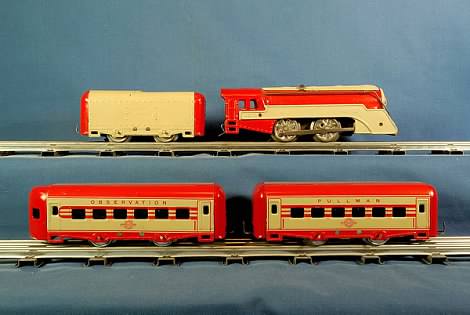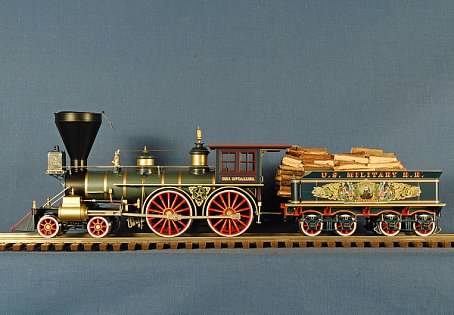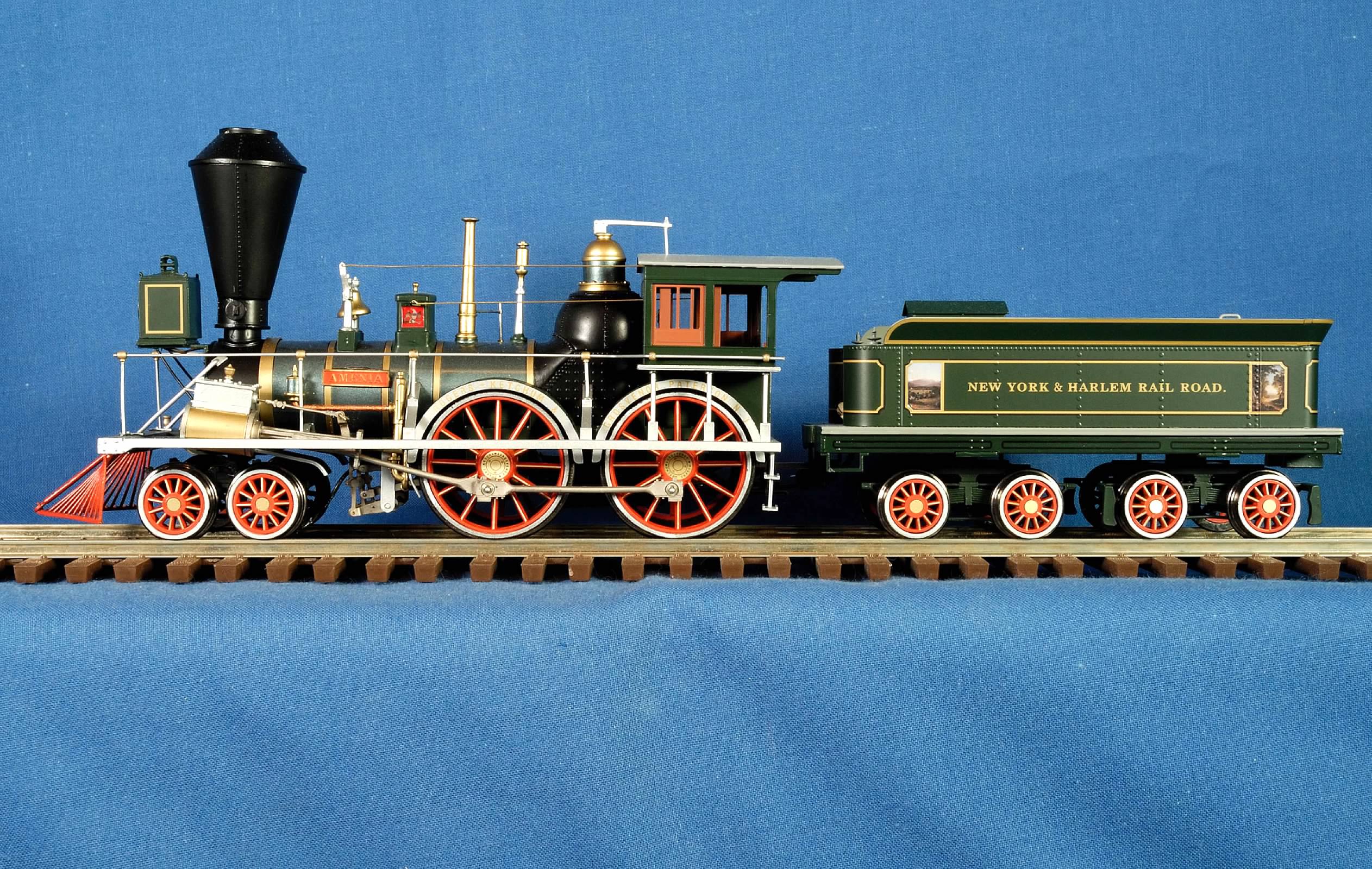|
|
Post by atsda on May 20, 2023 4:05:16 GMT
Shown in the photo is a side shot of an all-metal wind up (integral key) locomotive in fa  ir to poor condition. It may be a supposed representation of the locomotive that headed the 20th Century Limited (although a 4-6-4 was used). As it stands, the wheel configuration here is 0-4-0 (the set of front driver wheels provided propulsion); there is an empty hole on the underside of the chassis which once may have been occupied by a pilot truck. Under the firebox, there is a mounted bell that is loosely riveted on. There is no striker connected to the wind up mechanism. There may have been a trailing truck that had a way of striking the bell. The loco is missing its headlamp housing; although it has handrails and the streamlined skirting. There is a lever at the top to engage/ disengage the wind up mechanism. A size comparison can be made with the O gauge cars on the lower track. The story behind the acquisition: My father brought this home in the 50’s when I was a kid. He was working on the Upper Eastside of Manhattan; someone gave it to him in a box of O27 tracks. Obviously, the tracks were not for it; none the less, it did work with them. We never had trains under the Christmas tree; however, I made a large loop on a 4’ x 4’ platform under the Christmas tree for my family, and ran this loco through the village – 8 turns on the mechanism, and it would go around about 4 or 5 times. We had great fun with it. What are your thoughts about it? Alfred |
|
|
|
Post by david1 on May 20, 2023 4:12:02 GMT
Looks like a Marx wind up train, very interesting,
Dave
|
|
|
|
Post by harborbelt70 on May 20, 2023 6:28:50 GMT
This is a favorite side shot for me, which I happened across some years back without info as to when and where it was taken. All that you can tell is that someone put an O scale FEF3 set with an AWT on the main driving rod of UP 844[4] when it was in black livery:


|
|
|
|
Post by af3020 on May 20, 2023 14:14:48 GMT
The engine is Hafner. The bell striker should have a small extension arm which hangs down below the drive wheel tread. When running the extension arm will hit the ties in the train track and ring the bell. These engines were just 0-4-0 in configuration and their consists were lithographed to represent the more streamlined passenger cars of the era. Below is an example of one of these sets.  Note: According to my references, your style of engine (#1010) was introduced in 1938 and was manufactured into the post-war 1940's. It came in three styles - top shroud and sideboards, sideboards only, sideboards which ran only about half the length of the side of the engine (starting from the front) and finally no sideboards or top shroud. |
|
|
|
Post by JKP on May 20, 2023 20:02:57 GMT
|
|
|
|
Post by Adam on May 20, 2023 20:44:52 GMT
B&M GP-40, MTH Premier PS3 Very reliable and strong pulling engine.  |
|
|
|
Post by rtraincollector on May 20, 2023 20:55:57 GMT
Here is mine, Standard Gauge 402  |
|
|
|
Post by atsda on May 21, 2023 2:50:30 GMT
The tin lithograph loco shown in the photo features the Hafner imprint and number 1010 and is a O gauge model used on two rail tracks. Alfred Some additional info follows:
Hafner trains
Hafner Mfg. Co. founded by W.F. Hafner in Chicago, Illinois, and operated from ca. 1900 to 1950 and was specialized in 'O' gauge toy trains.
The company joined with Edmunds-Metzel Co. in 1907 to manufacture mechanical toys and trains, became American Flyer Manufacturing in 1910 and was sold to Wyandotte in 1950.
Early Hafner trains
Early toy trains had the Overland Flyer brand and resembled competing offerings from American Flyer. As late as 1917 a car appeared in American Flyer's product line that closely resembled a Hafner design. This suggests the two companies worked together in their early days, or that one or both companies copied designs from the other. Since American Flyer was known to have purchased rolling stock from German competitor Bing, it is possible that American Flyer also purchased from Haefner, or vice versa.
Unlike its competitors, the Hafner company survived the Great Depression without making significant changes to its product line, since it always specialized in cheap train sets that sold for only 3 USD or less. WWII proved a greater challenge, because toy production was prohibited after 1942, and toy companies had to adapt. Hafner lacked the tooling and manufacturing expertise to secure government contracts to manufacture items with military use, like Lionel and the A. C. Gilbert Company. Hafner survived by producing bottlecaps for the Fox Brewing Company.
After son John Hafner took over the firm in 1933, he also faced these difficulties, and by 1956 it was out of business and in liquidation. Louis Marx and Co. purchased the Hafner tooling, then shipped it to its subsidiary in Mexico, where it was used to produce inexpensive windup and battery-powered sets. Many Marx collectors believe Louis Marx's primary motivation for the purchase was to eliminate a competitor from the marketplace.
The clockwork locomotives and colorful lithographed tinplate rolling stock placed Hafner at the low end of the market. Unlike most of its competitors, Hafner never created an electric train. Any Haefner electric trains that exist today were retrofitted with a motor from another manufacturer. Electrifying Hafner locomotives by outfitting them with surplus Marx electric motors is a somewhat common practice.
Both Hafner and Marx were known to use 'recycled' lithography, a cost-saving practice where the tinplate from defective print runs was flipped over and printed on the blank side and used. The result of this is hidden graphics on the interior of cars and accessories. In addition to re-using its own defective sheets, Hafner would sometimes buy defective sheets from other companies as scrap and use it. Some Hafner collectors specialize in collecting these variations. Additionally, some metal products from the mid-20th century such as flashlights have surfaced with Hafner lithography inside, which indicates that Hafner sold its surplus or unusable print runs for use in the manufacture of products that would be painted.
.
|
|
|
|
Post by atsda on May 21, 2023 2:53:12 GMT
AF3020, Welcome to OGF. Spot on. Thanks for your expert analysis. Alfred
|
|
|
|
Post by harborbelt70 on May 21, 2023 5:17:58 GMT
Another favorite side shot of mine, and another example of 3rd Rail’s fine detailing in O scale, is this N&W “Jawn Henry” steam turbine. The doghouse on the water tender must have bragging rights for biggest of its kind, but it’s the other detail on the water tender that stands out most.

I believe that the cylinder in the front of the tender was used to deliver pressurized and pre-heated water to the engine. Like the UP coal turbine, the locomotive was a one-off experiment that was too problematic for regular service.
Side shot of the whole set made by 3rd Rail with a second water tender:

|
|
|
|
Post by thebigcrabcake on May 21, 2023 12:51:24 GMT
Canadian National Side Shot.


|
|
|
|
Post by af3020 on May 21, 2023 13:40:28 GMT
This has always been one of my favorites.  |
|
|
|
Post by harborbelt70 on May 21, 2023 16:42:34 GMT
This has always been one of my favorites. 
|
|
|
|
Post by af3020 on May 21, 2023 18:38:04 GMT
It was made by SMR trains. They turned out a series of Civil War 4-4-0's, PRR 4-4-0's D6 and D6a from the 1880's and several V&T engines. In addition to this they made some very nice Civil War passenger and freight cars, passenger cars to match the PRR engines, and a caboose and some freight cars for the V&T engines. Below is another example of their work.  |
|
|
|
Post by Adam on May 21, 2023 21:29:39 GMT
Great looking General style engine. I’ve never heard of this manufacturer but they seem to do good work.
|
|